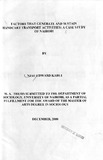| dc.description.abstract | The major objective of the study was to explore factors that ,
generate and sustain handcart transport activities, in the
streets of Nairobi. This entailed a thorough exploration of
handcartpullers pertaining to their Socio-economic and
demographic backgrounds as well as the economic and
operational characteristics of the activity.
Entry into handcart transport activities was the first
dependent variable. The socio-economic and demographic
factors selected as independent variables included;
duration of urban residence family size, number of
dependants level of education ,landownership before
joining this activity, previous activities and previous
incomes.
Economic characteristics selected as independent
variables included incomes from the activity, capital
required to enter the activity, sources of capital and the
activity's employment capacity.
Investigation of the operational characteristics of the
activity involved an analysis of the activity in terms of
organization, nature of trip patterns, transportation costs,
sources of competition, cargo characteristics, quality of
transport, nature and availability of infrastructure used by
the mode, the location characteristics among others.
The study was based on a sample of 120 respondents
randomly selected from each of the 8 locations purposively
selected
Data collection techniques were mainly primary
with Questionnaires being the main data collection
instruments.
other data collection methods such as direct and participant
observation were also used .Secondary data from available
records were also used. These were mainly drawn from
National Development Plans and the Economic surveys which
provided data of a statistical nature.
Data analysis was done through descriptive statistical
methods using frequencies and percentages presented in form
of tables to show patterns of relationships.
The findings indicate that handcartpullers' poor Socio~
economic backgrounds exert great influence towards their
entry into handcart transport activities. Most of the
pullers have little formal education, lack requisite
technical skills and resources such as land which leaves
them with no hope of getting absorbed into the competitive
formal or informal sectors.
As a result of their poor backgrounds most of the pullers
were found to have been previously unemployed or
engaged in occupations that were less demanding in terms of
education, technical skills and capital.
The study further revealed that the operational
characteristics of handcart transport make it enjoy a
natural monopoly as a mode of goods carriage wi thin the
city This was found to apply where the distances and nature
of goods involved make it uneconomical to use motorized
means of transport.
In conclusion, the study recommends several policy
intervention measures for improving and developing the sub
sector among them need to stimulate demand for handcart
transport services, institution of educational programmes to
enlighten and empower handcartpullers and improvement and
expansion of infrastructure | en |

